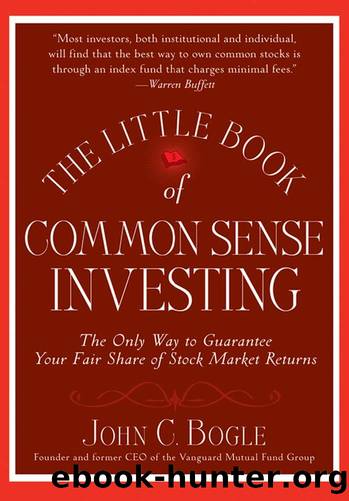Little Book Of Common Sense Investing (BOGLE John 2007 Wiley) by BOGLE John

Author:BOGLE John [John, BOGLE]
Language: eng
Format: epub
Published: 2007-05-03T06:09:04+00:00
Average return of funds recommended
by advisors: 2.9 percent per year.
For equity funds purchased directly: 6.6 percent.
Specifically, the study found that adviser asset alloca-tions were no better, that they chased market trends, and that those they advised paid higher upfront charges. The studyâs conclusion: the weighted average return of equity funds held by investors who relied on advisers (excluding all charges paid up front or at the time of redemption)â
averaged just 2.9 percent per yearâcompared with 6.6
percent earned by investors who took charge of their own affairs.
This powerful evidence, however, does not bring the researchers to the clear conclusion that advice in its totality has negative value: âWe remain,â the report states, âopen to the possibility that substantial intangible benefits exist, and will undertake more research to identify these intangible benefits and explore the elite group of advisers who do improve the welfare of households who trust them.â
There is other powerful evidence that the use of stockbrokers (as distinct from financial advisers) has a strong negative impact on the returns earned by fund investors. In a study prepared for Fidelity Investments covering the 10-year period 1994 to 2003 inclusive,
bogl_c10.qxd 2/8/07 10:25 AM Page 105
S E E K I N G A DV I C E TO S E L E C T F U N D S ?
[105]
broker-managed funds had the lowest ratings relative to their peers of any group of funds. (The other groups included funds operated by privately owned managers, by publicly-owned managers, by managers owned by financial conglomerates, and by bank managers.) The Merrill Lynch funds were 18 percentage points below the fund industry average; the Goldman Sachs and Morgan Stanley funds were 9 percentage points below average; and both the Wells Fargo and Smith Barney funds were 8 percentage points behind. Part of the reason for this disturbing performance may arise from the nature of the job. The brokerage firm and its brokers/financial consultants must sell something every single day. When the firm introduces a new fund, the brokers have to sell it to someone. (Imagine a day when nobody sold anything, and the stock market lay fallow, silent all day long.) A Merrill Lynch example illustrates the destructive challenges that are often faced by investors who rely on stockbrokers. In March 2000, just as the bubble created by the Internet stock craze reached at its peak, Merrill Lynch, the worldâs largest stock brokerage firm, jumped on the bandwagon with two new funds to sell. Both were ânew economyâ funds. One was a âFocus Twentyâ fund (based on the then-popular theory that if a managerâs 100 favorite stocks were good, surely his 20 favorites would be even better). The other was an âInternet Strategiesâ fund. The
bogl_c10.qxd 2/8/07 10:25 AM Page 106
[106]
T H E L I T T L E B O O K O F C O M M O N S E N S E I N V E S T I N G
public offering of the two funds was an incredible success.
Merrillâs brokers pulled in $2.
Download
This site does not store any files on its server. We only index and link to content provided by other sites. Please contact the content providers to delete copyright contents if any and email us, we'll remove relevant links or contents immediately.
| Analysis & Strategy | Bonds |
| Commodities | Derivatives |
| Futures | Introduction |
| Mutual Funds | Online Trading |
| Options | Portfolio Management |
| Real Estate | Stocks |
Rich Dad Poor Dad by Robert T. Kiyosaki(6511)
Pioneering Portfolio Management by David F. Swensen(6253)
How To Win Friends and Influence People by Dale Carnegie(4470)
The Money Culture by Michael Lewis(4132)
The Dhandho Investor by Mohnish Pabrai(3722)
The Wisdom of Finance by Mihir Desai(3693)
Liar's Poker by Michael Lewis(3413)
Fooled by Randomness: The Hidden Role of Chance in Life and in the Markets by Nassim Nicholas Taleb(3080)
The ONE Thing by Gary Keller(3031)
The Intelligent Investor by Benjamin Graham Jason Zweig(3010)
Mastering Bitcoin: Programming the Open Blockchain by Andreas M. Antonopoulos(3010)
Rich Dad Poor Dad: What The Rich Teach Their Kids About Money - That The Poor And Middle Class Do Not! by Robert T. Kiyosaki(2928)
How to Day Trade for a Living: Tools, Tactics, Money Management, Discipline and Trading Psychology by Andrew Aziz(2924)
Investing For Dummies by Eric Tyson(2920)
How to Win Friends and Influence People by Dale Carnegie(2883)
The Psychology of Money by Morgan Housel(2798)
Market Wizards by Jack D. Schwager(2669)
Zero Hour by Harry S. Dent Jr. & Andrew Pancholi(2628)
How to Pay Zero Taxes, 2018 by Jeff A. Schnepper(2621)
